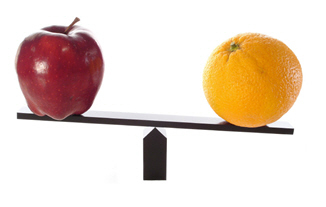How to Teach Comparatives and Superlatives


Teaching degrees of comparison will take several lessons. Your students should have a good grasp of comparison related vocabulary such as tall, short, big, small, fast, slow, etc and initially, your lessons should revolve around only about ten or twelve of these. If students perform well using the set of words you have chosen, you can add more vocabulary later.
Warm up – Review
It has probably been a while since your students have thought about the vocabulary you plan to use for this lesson so it is important to review their meaning and pronunciation. You can do this by conducting a warm up activity such as crisscross or by asking for volunteers to give you the definitions of words, spell words on the board, or use words in a sentence. At the end of this activity there should be two columns of words on the board. With the sample vocabulary above, the columns would look like this.
| tall | short |
| big | small |
| fast | slow |
The two columns should have enough space between them for you to write their comparative and superlative forms.
Introduce – Comparative
Introduce comparative structures to your students without explaining them first. Play a short true or false trivia game saying sentences like “Russia is bigger than England.” Use hand gestures to suggest the meaning of each new word and try to have a student translate the sentence before asking whether it is true or false. Use the comparative form of each vocabulary word in a trivia question and write it down next to the word as you go. At the end of the game, underline the –er ending of each comparative form and explain the comparative structure. Your students already have most of it figured out at this point so after some pronunciation practice or drilling, let them give it a try.
Practice/Production - Comparative
Worksheets can help your students practice but a more enjoyable way to practice degrees of comparison is to play a card game. Students should play in groups of three to five. You can make decks of between thirty and fifty cards where each card has an animal, for instance, and statistics for that animal such as height, speed, etc. There are many games you can play with a deck such as this one. Have students shuffle and deal all the cards. Explain that the student whose turn it is should choose a category such as height, he and the student sitting to his left should each play a card, and the student whose animal is taller should say “The ~ is taller than the ~.” or more simply “My animal is taller than yours.” That student now gets to keep both cards and the student with the most cards at the end of the game, is the winner.
Introduce – Superlative
Usually the following class would focus on superlative forms. They can be introduced in much the same way you introduced the comparative structure. Emphasize the –est ending and conduct some choral repetition as pronunciation practice. Continue to use the same set of vocabulary.
Practice – Superlative
Practice activities such as worksheets or card games would be appropriate for the superlative form too. Worksheets could include fill in the blank, matching, and write your own sentences sections. The card game above could be adapted to practice superlative. Students could all put down a card after the category is announced, the student with the highest number in that category would make a sentence and keep the cards, and the winner would be the student with the most cards at the end of the game. You could also change the game entirely or use one card game in the first superlative class and change it for the second class if students are really enjoying them.
Production – Combine!
After doing some short practice activities of both comparative and superlative forms that have already been covered, introduce one or two vocabulary words that use more and most to create their comparative and superlative forms. Make sure all the vocabulary words as well as their comparative and superlative forms are written on the board before conducting a combination exercise. A board game of boxes leading from start to finish would be ideal for groups of three or four. A turn would consist of a student rolling a die, moving her piece, and creating a sentence based on the image in the square she landed on. This game should use both the comparative and superlative forms of each vocabulary word. The first student to reach the last square wins.
Review
The card game and board game require your students to do a lot of speaking so they have practiced extensively by the time they have finished. A short quiz will check your students’ understanding of the degrees of comparison and determine if further review is necessary.
Degrees of comparison are often easy to introduce and fun for students to practice. Since students already understand the meaning of the vocabulary they are using in these lessons, it is much easier for them to grasp than other structures where new vocabulary is introduced. Including comparative or superlative forms in later activities will help keep them fresh in your students’ minds.